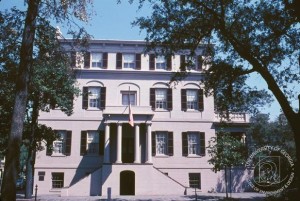 Richard Vonalbade “Von” Gammon played on some of UGA’s earliest football teams. He quarterbacked the team in 1896, then played fullback and on defense for the 1897 team. That team won their first two games against Clemson and Georgia Tech. The third game was against the University of Virginia, played in Atlanta on October 30. Early in the second half, Von Gammon charged into a large group of players in an attempt to make a tackle. When the play was over and the players unpiled, Gammon lay motionless on the ground. Several teammates tried to communicate with him, but he was unable to speak. He was carried to the sidelines, where he began vomiting. Two doctors in the stands came to Gammon’s aid and injected morphine into his chest in an attempt to revive him, but they soon determined that he had a severe concussion. He was rushed to Grady Hospital in an ambulance, but there was nothing more the house surgeon could do. Von Gammon died from his injury early in the morning of October 31. The Macon Historic Newspapers Archive includes an article from The Macon Telegraph that reports the events of October 30.
Richard Vonalbade “Von” Gammon played on some of UGA’s earliest football teams. He quarterbacked the team in 1896, then played fullback and on defense for the 1897 team. That team won their first two games against Clemson and Georgia Tech. The third game was against the University of Virginia, played in Atlanta on October 30. Early in the second half, Von Gammon charged into a large group of players in an attempt to make a tackle. When the play was over and the players unpiled, Gammon lay motionless on the ground. Several teammates tried to communicate with him, but he was unable to speak. He was carried to the sidelines, where he began vomiting. Two doctors in the stands came to Gammon’s aid and injected morphine into his chest in an attempt to revive him, but they soon determined that he had a severe concussion. He was rushed to Grady Hospital in an ambulance, but there was nothing more the house surgeon could do. Von Gammon died from his injury early in the morning of October 31. The Macon Historic Newspapers Archive includes an article from The Macon Telegraph that reports the events of October 30.
The Macon Telegraph, Oct. 31, 1897

News of his death spread throughout the state causing shock and outrage. There were accusations that the Virginia players had been intentionally rough on the play, but this was quickly denied by players of both teams. In fact, the Virginia players were as devastated by the news as were the citizens of Georgia. As a result of the incident, every college in Georgia with a football program voluntarily disbanded their teams (this included the University of Georgia, Georgia Tech, and Mercer). The Georgia General Assembly was in session at the time, and on November 1, 1897, a member of the House of Representatives introduced a resolution outlawing football in the state; it passed by a vote of 91-3. The Senate followed with a vote outlawing football on November 18; it passed 31-4. The bill only needed the signature of Georgia governor William Y. Atkinson to become law and end football in the state. Several articles from the Athens Daily Banner, available in the Athens Historic Newspapers Archive address the status of football at the University of Georgia.
Other newspaper editorials supported the movement to end football in Georgia, whether by legislation or voluntarily on the part of the players, such as this one from The Macon Telegraph.
The Macon Telegraph, Nov. 21, 1897

It was at this point that Von Gammon’s mother, Rosalind Burns Gammon, intervened. Despite her grief at her son’s death, she did not want the sport outlawed. She penned a letter to her local representative, which said:
“It would be the greatest favor to the family of Von Gammon if your influence could prevent his death being used for an argument detrimental to the athletic cause and its advancement at the University. His love for his college and his interest in all manly sports, without which he deemed the highest type of manhood impossible, is well known by his classmates and friends, and it would be inexpressibly sad to have the cause he held so dear injured by his sacrifice. Grant me the right to request that my boy’s death should not be used to defeat the most cherished object of his life. …“
After learning about the letter and Mrs. Gammon’s feelings, Governor Atkinson vetoed the resolution on December 7, 1897, and ended the movement to ban football in Georgia.
The Athens Daily Banner, Dec. 8, 1897

Mrs. Gammon is now revered in Georgia lore as the woman who saved college football for the state. In 1921, surviving members of the University of Virginia football team presented a plaque to the University of Georgia in honor of Von Gammon and his mother when the two schools met to play on November 5.
The Red and Black, Oct. 28, 1921



On October 30, 1997, one hundred years to the day after the game in which Von Gammon was fatally injured, the University of Georgia’s student newspaper The Red and Black ran a story on him and his mother; it showed UGA’s senior linebacker Greg Bright reading the plaque presented by members of the Virginia football team in 1921, and the written plea from Mrs. Gammon to Governor Atkinson to keep Georgia football alive.
The Red and Black, Oct. 30, 1997

Digital Library of Georgia resources used for this blog entry:
Macon Historic Newspapers Archive
Athens Historic Newspapers Archive
The Red and Black: An Archive of the University of Georgia Student Newspaper







